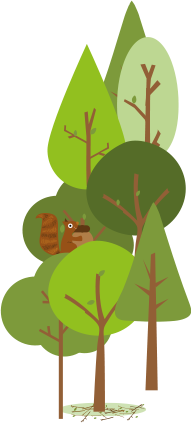

The Lost Words November: Ivy
26th November 2020
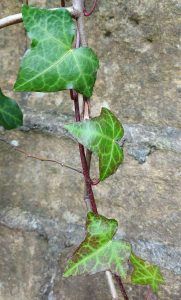
Dear Ivy,
In the past, people called you Bindwood and Lovestone. You still find a way to stick to everything, not letting go easily. You aren’t afraid to keep climbing high, the top branches are within easy reach.
If you can’t find a way up, you spread out in the shade below. I love how you stay green all year, adding colour to the misty days. You peek out as we walk by, singing your carol into the icy night. Some believed you could ward off evil. You wear your heart on your leaves.
Do you notice how grateful the birds are for your berries, when there is little else to eat? Do you mind that the bats shelter underneath your blanket cover? You are lucky to have their company as the rest of the natural world slows down and hides away until spring.
Quietly bold. On the move.
by Clare Proctor
It grew large and untamed along the stone wall that separated the village church and school playground. A perfect, green den, welcoming us in on rainy days. Happy memories of sitting under its leaves as it provided the perfect vantage of the whole playground and children busy within it are still vivid in my mind.
Fast forward nearly three decades and you will often find me sat in our back garden, a quiet triangle enclosed again by stone walls topped with towering cascades of ivy. Each year blackbirds nest in it, and I imagine them to feel like we did in that small school playground – queens of an emerald fortress, quietly sitting whilst watching the bustle of life enfold around them.
Something about ivy’s constant nature together with the predictability of the returning birds is comforting and especially after this year, I’m look forward to this next spring even more – a return to (hopefully) more normal times, signalled by our blackbird family safely nestled in the ivy’s leaves.
by Lauren Emsley
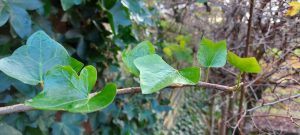
Invincible ivy you inhabit walls, inviting shelter for winter’s invisible insects
Vertiginous climber, you venture high, twisting like vine to reach your rooftop vantage point
Year’s end, you yield food for hungry yearning birds, yet come Yuletime, its holly, not you, who wears the crown
by Annie Berrington
Gratitude for ivy…
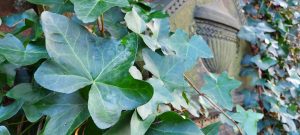
Ivy also has a bad reputation for damaging walls and buildings, which support it. But how pretty does it look? I love an old building with ivy climbing up the walls. It’s even been found that it can help preserve stonework on some old buildings. So maybe ivy encroaching on our human world isn’t so bad after all? Ivy is also sometimes confused with poison ivy which grows in North America, but English ivy is harmless.
In the past ivy was a symbol of intellectualism and so wreaths were used to crown poetry competition winners in ancient Rome. Ivy wreaths were also given to winning athletes in ancient Greece. In addition, it was a symbol of fidelity so priests would present a newly married couple with a wreath of Ivy. Now, it is tradition for the bride to have a sprig of ivy in her bouquet.
So, love it or hate it, ivy cannot be ignored! In fact, I’m grateful for the winter colour it gives, the species it supports and the beauty it provides.
by Julia Babbitt
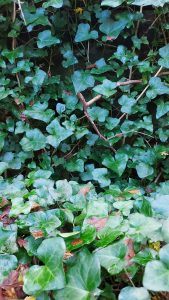
I adore the shape and variegated tones of this beautiful plant, nevertheless, be mindful how unruly it is, if not carefully managed. Used in many Christmas decorations and also known for its its medicinal properties, ivy is a wonderful accompaniment to the English garden and woodlands.
by Hazel Thompson
At first, I thought Ivy was not the most inspiring or awe inducing word in the Lost Words book by Robert McFarlane. It’s just kind of there isn’t it, everywhere you look. At least it is in my garden. Ivy of one sort and another, and its an endless task trying to keep it from taking over everything. Writing this blog post however has made me re-think my feelings towards Ivy. Think about it – what else in the plant world is as resilient and strong and always growing. It survives all seasons, forever green and beautiful, flowering and feeding others. So I’ve decided, Ivy is my new inspiration. I will aim to be as resilient as Ivy. I will aim to keep growing and aim for the sky. I will climb straight over whatever obstacles come my way. I will be tough – Ivy tough!
Susan Eardley

